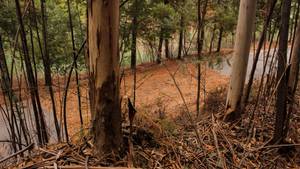Left of Centre - 2017

In Situ3 Workshop, 18 - 29 Sept 2017
“If you want me
You can find me
Left of center
Off of the strip
In the outskirts
In the fringes
In the corner
Out of the grip”.
- Suzanne Vega, singer songwriter, Left of Centre[1]
Since the advent of digital technology our lifestyles have become frenetic; everyone is constantly in a hurry. In his book In Praise of Slowness, Carl Honoré dissects our speed-obsessed society and celebrates those who have connected with their "inner tortoise." He believes “we’re so marinated in the culture of speed that we fail to notice the toll it takes on our productivity, lives, health, work, and relationships.”[2]
The novel, Slowness, by the Czech-born French writer, Milan Kundera also investigates our contemporary obsession with speed and suggests that: There is a secret bond between slowness and memory, between speed and forgetting:
“A man is walking down the street. At a certain moment, he tries to recall something, but the recollection escapes him. Automatically, he slows down. Meanwhile, a person who wants to forget a disagreeable incident he has just lived through starts unconsciously to speed up his pace, as if he were trying to distance himself from a thing still too close to him in time.
In existential mathematics that experience takes the form of two basic equations: The degree of slowness is directly proportional to the intensity of memory; the degree of speed is directly proportional to the intensity of forgetting.” [3]
These short paragraphs of Kundera and Honoré contain implications of tempo and its effects on our lives. Therefore this workshop for In Situ students in Ponte da Mucela (mid Portugal) will focus on the awareness of the temporal nature of the comings and goings and the rhythmic patterning of a particular area.
This workshop will hinge on slow mindful responses. Students will be expected to consciously become aware of the moment they are in – absorbing literally and metaphorically the shapes, layers, tones and textures of the small village, the surrounding landscape and its local inhabitants. It is an opportunity for you to be unhurried, take time out, retreat to an environment away from the city; left of centre, on the outskirts and the fringes in a remote corner of the world to render quality work and contemplate your art practice.
Ponte da Mucela is a peaceful area, with its own particular rhythm. However, the place bears witness to stark contrasts such as extreme fluctuation in temperatures, lush green river banks, dry, sandy earth and fascinating rock formations. Historical and recent disasters, like forest fires and floods have left a legacy of, marks and scars in the territory as well as intriguing colour tones. The light conditions fluctuate from clear starry skies to quiet misty mornings and harsh mid-day shadows.
Such successive stimuli (temporal patterning) and its impact on the local content of life contributes to what the organisation Common Ground[4] call ‘local distinctiveness’, and what the relational geographers, Nigel Thrift and Doreen Massey terms ‘ecologies of place’[5]. Massey (2005:141) writes, that “our temporary meeting up with rocks, stones and trees requires, in one way or the other, a confrontation with the challenge of a non-human negotiation”. We agree with the American philosopher, Thomas Nagel[6] (quoted in Jonathan Metzger 2014:13)[7] who is of the opinion that an objective perspective to describe a place is the "view from nowhere” he states that that the only valuable ideas about spaces and places are ones derived independently and subjectively. These theorists all support the role that artists play in enabling community action as well as expressing their own mindful engagement with the environment.
Slowness does not mean doing nothing. Unique knowledge as well as pleasure can be gained from reducing one's pace. It is about giving yourself time to reflect on the value, quality and meaning of the experiences you will undergo. When savouring and prolonging moments one moves and acts slowly and discovers nuances which are intellectually stimulating. All too often the contemporary cult of speed encourages rash decisions which result in failure.
Sources
[1] Vega, S and Addabo, S. 1986. Left of Center. Soundtrack for the film Pretty in Pink.
[2] Honoré, C. https://www.ted.com/talks/carl_honore_praises_slowness (accessed on July 18, 2017).
Honoré, C. 2005. In praise of slowness. London: Orion.
[3] Milan Kundera https://www.goodreads.com/quotes/272845-there-is-a-secret-bond-between-slowness-and-memory-between. Kundera, M. 1995. Slowness. London: Harper Collins.
[4] Common ground is an organisation, founded in London in 1982 (and is still very active) under the leadership of Susan Clifford and Angela King. This collective has initiated social and environmental concepts through a series of prominent creativities in the UK, often connecting communities with artists. They have worked extensively with well-known artists like Andy Goldsworthy and Peter Randall-Page.
[5] Massey, D. 2005. For space. London: Sage. Thrift N and Massey D. 2003. The passion of place in A century of British geography, Ron Johnston, Michael Williams (eds), Oxford: British Academy: 275-284.
[6] Nagel, T. 1986. The view from nowhere. New York: Oxford Univ. Press.
[7] Metzger, J. 2014.The subject of place: staying with the trouble. Emergent Urbanism: Urban Planning & Design in Times of Structural and Systemic Change. Haas & Olsson (eds), Aldershot: Ashgate. https://www.kth.se/profile/jmetzger (accessed July 16, 2017). https://www.kth.se/profile/jmetzger.